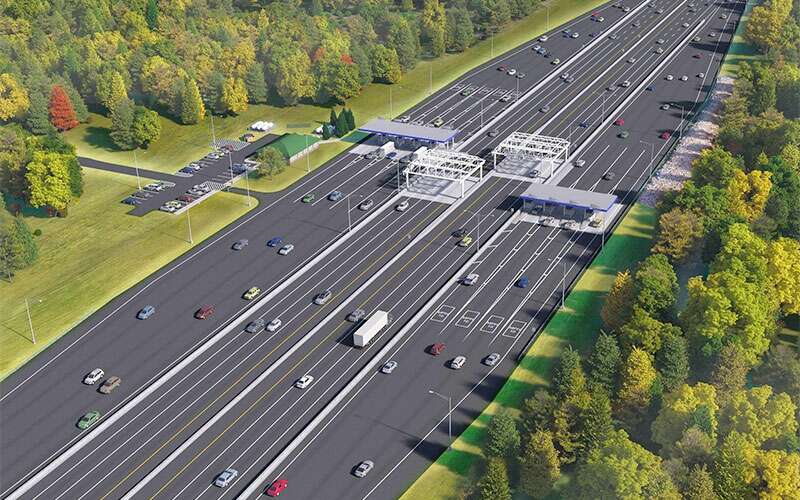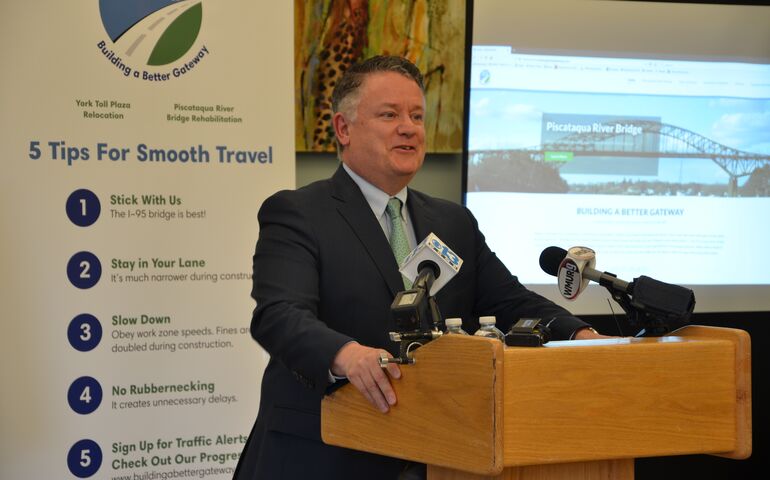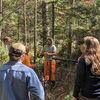
Two-state $93M initiative to reduce 'gateway’ traffic woes coming into Maine
 Courtesy / Ethos
Bruce Van Note, commissioner of Maine Department of Transportation, talks about the “Maine Ahead: Building a Better Gateway” initiative at Wednesday's press conference in Kittery.
Courtesy / Ethos
Bruce Van Note, commissioner of Maine Department of Transportation, talks about the “Maine Ahead: Building a Better Gateway” initiative at Wednesday's press conference in Kittery.
The Maine Department of Transportation, the Maine Turnpike Authority, and the New Hampshire Department of Transportation unveiled Wednesday an initiative to revitalize the heavily trafficked Interstate 95 “gateway” to Maine between Kittery and York.
The “Maine Ahead: Building a Better Gateway” initiative focuses on two major construction projects on the I-95 corridor — the Piscataqua River Bridge, which MaineDOT will begin upgrading in June, and the replacement of the York Toll Plaza, which Maine Turnpike Authority started last fall.
Because the two infrastructure projects are happening at the same time, MaineDOT and Maine Turnpike Authority are collaborating to increase communications and safety. All communications for both infrastructure projects will be centralized under “Maine Ahead: Building a Better Gateway,” which will include a website with a traffic alert sign-up system, and social media channels to follow for updates related to these projects.
“The goal of ‘Maine Ahead’ is to modernize and improve safety and mobility on the eight-mile stretch of interstate that runs from New Hampshire, over the Piscataqua River Bridge, and through the York Toll Plaza,” said Bruce Van Note, commissioner of the Maine Department of Transportation. “This endeavor is about revitalizing Maine’s iconic southern gateway to create easier access, better traffic flow and highway-speed tolling — all important to the state’s long-term future, economic stability, and growth, especially as visitors to our state increase.”
In 2018, 37 million tourists visited Maine: a 33% increase from 2012 tourism numbers. Every day, 74,000 vehicles cross the Piscataqua River Bridge, and in the summer, that daily traffic number can climb to 130,000 vehicles. More than 15 million transactions occur at the York Toll Plaza each year. Labor Day 2018 saw record-breaking traffic at the York Toll Plaza: 70,000 vehicles, representing a 5.3% increase from the previous year’s traffic.
“With that growth comes increased travel through Maine’s southern gateway,” said Peter Mills, executive director of the Maine Turnpike Authority. “That increase has led to a rise in backups and traffic jams at the state’s southern gateway — a development that doesn’t benefit anyone. ‘Maine Ahead’ will modernize two of Maine’s iconic entry points — the Piscataqua River Bridge and the York Toll Plaza — helping to alleviate congestion and keep traffic moving, especially during peak travel periods without increasing toll prices.”
Streamlined communications and community meetings
To make it easier for drivers to get the information they need about the two infrastructure projects, MaineDOT and the Maine Turnpike Authority are centralizing communications for the two projects. In addition to their existing travel alert subscriptions and social media channels, travelers are encouraged to:
- Visit the “Maine Ahead” website at buildingabettergateway.com to sign up for traffic alerts from MyTrips New England 511.
- Like and follow “Maine Ahead News” on Facebook and Twitter.
- Invite friends and family to become part of the “Maine Ahead” community on social media.
“We want to reassure travelers and commuters that we have them in mind and are going to be doing everything in our power to keep motorists safe and traffic moving,” said Van Note. “We realize it’s critically important to keep travelers and commuters in the loop.”
With the beginning of the summer travel season just weeks away, MaineDOT and the Maine Turnpike Authority have also scheduled a community meeting for June 25 at the Kittery Community Center from 4 p.m. to 6 p.m. to provide progress updates on the two construction projects and to answer questions from community members. Additional community meetings will be scheduled in the fall to help share important updates and address any potential impacts.
Van Note continued MaineDOT plans to keep all six lanes of the bridge open during daylight hours between Memorial Day and Columbus Day and on major national holidays. Lane closures will only occur in the evening between the hours of 8 p.m. and 5 a.m.

Two major construction projects
Work on the Piscataqua River Bridge project begins in June and is expected to be completed in May 2022. The project includes the resurfacing of all six lanes, the replacement of traffic barriers, and improvements to other structural and electrical elements.
Additionally, the bridge is being primed for a possible Intelligent Transportation System, which may allow existing bridge breakdown lanes to be converted into a fourth travel lane (in both directions) to help ease traffic flow during peak travel times. MaineDOT and Maine Turnpike Authority currently plan to start that effort once the resurfacing and improvements are complete. The cost to repair the bridge is $52.6 million. MaineDOT shares the bridge work cost with NHDOT and Maine Turnpike Authority.
“The Piscataqua River Bridge is the most important bridge in our state,” said Van Note. “It’s the critical artery connecting Maine to New Hampshire and all points south. The bridge is almost 50 years old, and it is simply time to make repairs and improvements.”
The York Toll Plaza replacement project began last fall and is expected to be completed during the summer of 2021. Once completed, it will feature six new electronic highway-speed E-ZPass lanes (three in each direction), allowing motorists to travel without stopping.
Once the highway-speed E-ZPass lanes in each direction are open and operating, 1,800 vehicles per hour will be able to pass through each lane; that figure represents a 57% increase in capacity. When the project is complete, the York Toll Plaza E-ZPass lanes will be able to process 5,400 vehicles per hour in one direction. The cost to relocate the toll plaza to mile 8.8 on the Maine Turnpike and add high-speed tolling lanes is $39 million.
To help keep traffic moving and mitigate delays at the new toll plaza location, Maine Turnpike Authority plans to maintain three lanes of traffic in each direction throughout most of the construction. During the entire length of the project, the authority anticipates that there will only be 42 days when there will be fewer than three lanes open.
Here's what the stakeholders say
At Wednesday’s press conference, representatives from both the Maine State Office of Tourism and the Maine Motor Transport Association expressed support for “Maine Ahead.”
“Tourism is an important contributor to the Maine economy, generating approximately $6.2 billion in direct expenditures and over $600 million in total taxes, and supports nearly 110,000 jobs each year,” Steve Lyons, director of the Maine State Office of Tourism said. “About 80% of visitors to Maine arrive by car and the Maine Turnpike is one of the major gateways for these visitors.”
Lyons said that although in the short term, the improvements might slow traffic flow, “modernizing this key gateway will make traveling to the state easier for visitors for years to come so they can spend more time enjoying everything we have to offer, including our gorgeous coastline, beautiful lakes and mountains, unique villages, fabulous food and exceptional outdoor and cultural offerings.”
Brian Parke, president and CEO of Maine Motor Transport Association, agreed.
“These southern gateway projects are important to freight movement in our region,” he said. “The trucking industry moves Maine's economy and these changes will aid our members as they deliver safely and on time. Open-road tolling creates efficiency, mitigates wear on trucks, and benefits our professional drivers as they deliver the goods Mainers manufacture and consume.”
Mills said when the projects are completed “Maine will truly have an exceptional gateway that welcomes travelers, freight drivers, and commuters alike.”










0 Comments